【Pytorch】学习记录分享4——PyTorch 天气预测线性回归实例
2023-12-18 11:36:11
【Pytorch】学习记录分享4——PyTorch hub借鸡生蛋
1. hub使用教程
2. 结构性数据加载
2.1 数据格式入下
数据表中
year,moth,day,week分别表示的具体的时间
temp_2:前天的最高温度值
temp_1:昨天的最高温度值
average:在历史中,每年这一天的平均最高温度值
actual:这就是我们的标签值了,当天的真实最高温度
friend:这一列可能是凑热闹的,你的朋友猜测的可能值
year,month,day,week,temp_2,temp_1,average,actual,friend
2016,1,1,Fri,45,45,45.6,45,29
2016,1,2,Sat,44,45,45.7,44,61
2016,1,3,Sun,45,44,45.8,41,56
2016,1,4,Mon,44,41,45.9,40,53
2016,1,5,Tues,41,40,46,44,41
2016,1,6,Wed,40,44,46.1,51,40
......
import numpy as np
import pandas as pd
import matplotlib.pyplot as plt
import torch
import torch.optim as optim
import warnings
warnings.filterwarnings("ignore")
%matplotlib inline
features = pd.read_csv('temps.csv')
print(features.head(2))
print(features.shape)
print(features.describe())
print("mean:\n",features.describe().max(),end="\n")
print(features['week'].iloc[0])
print(features.groupby(['week']).mean())
#看看数据长什么样子
features.head()
print('数据维度:', features.shape)
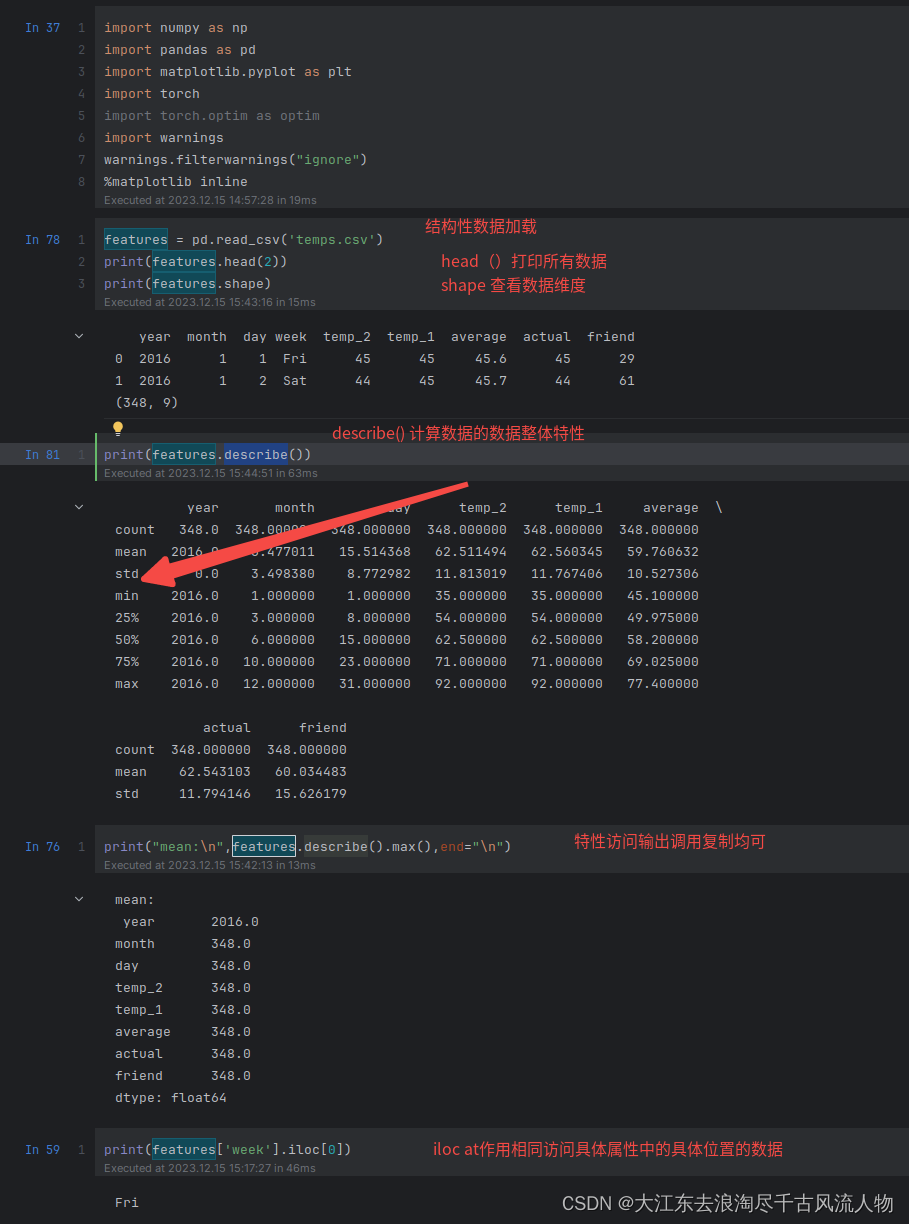
3 结构性数据显示
# 处理时间数据
import datetime
# 分别得到年,月,日
years = features['year']
months = features['month']
days = features['day']
# datetime格式
dates = [str(int(year)) + '-' + str(int(month)) + '-' + str(int(day)) for year, month, day in zip(years, months, days)]
dates = [datetime.datetime.strptime(date, '%Y-%m-%d') for date in dates]
dates[:3]
# 准备画图
# 指定默认风格
plt.style.use('fivethirtyeight')
# 设置布局
fig, ((ax1, ax2), (ax3, ax4)) = plt.subplots(nrows=2, ncols=2, figsize = (10,10))
fig.autofmt_xdate(rotation = 45)
# 标签值
ax1.plot(dates, features['actual'])
ax1.set_xlabel(''); ax1.set_ylabel('Temperature'); ax1.set_title('Max Temp')
# 昨天
ax2.plot(dates, features['temp_1'])
ax2.set_xlabel(''); ax2.set_ylabel('Temperature'); ax2.set_title('Previous Max Temp')
# 前天
ax3.plot(dates, features['temp_2'])
ax3.set_xlabel('Date'); ax3.set_ylabel('Temperature'); ax3.set_title('Two Days Prior Max Temp')
# 我的逗逼朋友
ax4.plot(dates, features['friend'])
ax4.set_xlabel('Date'); ax4.set_ylabel('Temperature'); ax4.set_title('Friend Estimate')
plt.tight_layout(pad=2)
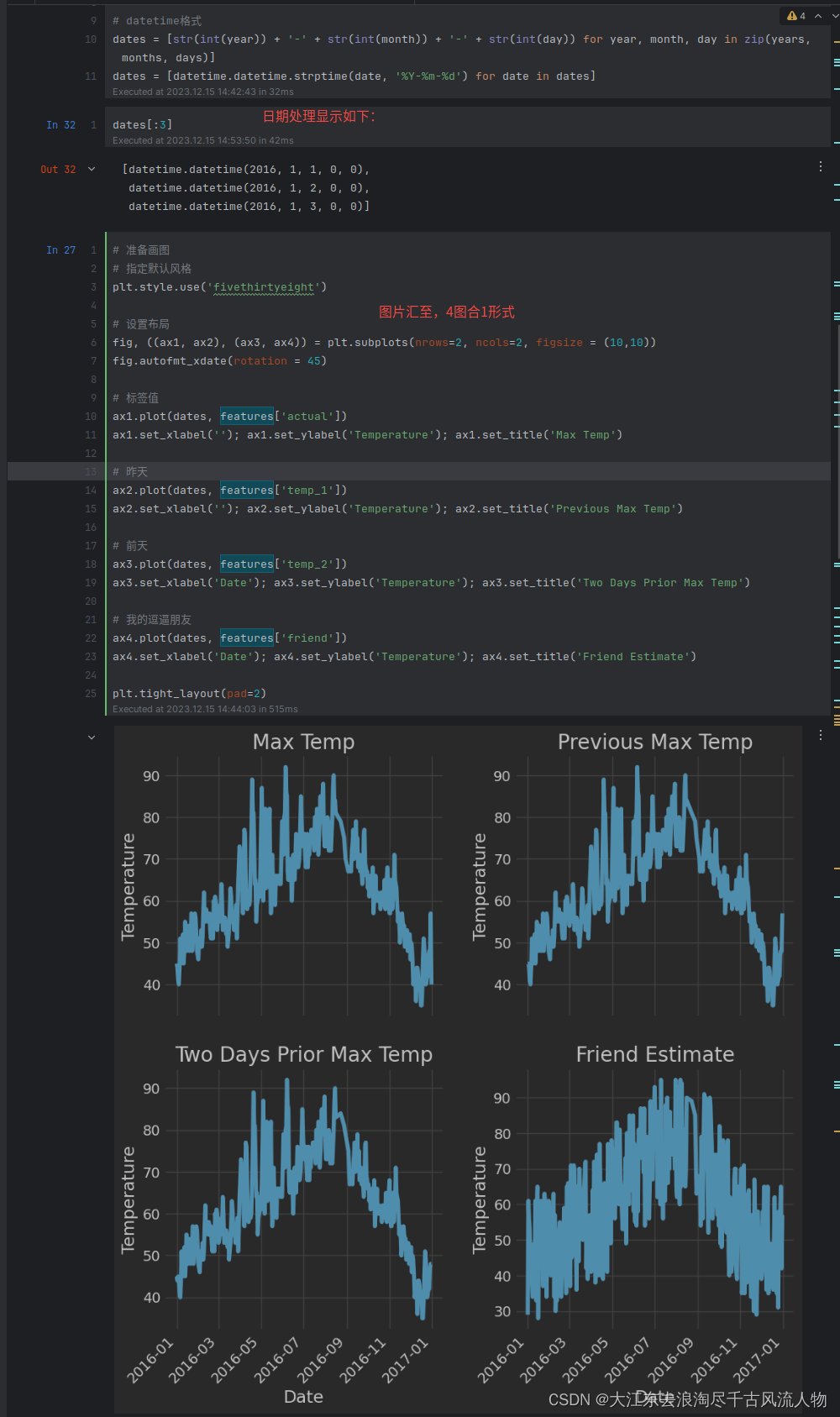
4 结构性数据预处理
# 独热编码
features = pd.get_dummies(features)
features.head(5)
独热编码是一种用于处理分类变量的方法,它将一个具有n个可能取值的分类变量转换成n个新的二元变量,每个二元变量代表了原始变量中的一个可能取值。这样做的好处是在使用机器学习算法时,可以更好地处理分类变量,因为大部分机器学习算法更适合处理数值型数据。
实现方法:
- 找到数据中的所有分类变量。
- 对每个分类变量的每个可能取值,创建一个新的二元变量,表示原始变量中的某个取值是否存在。
- 删除原始的分类变量列,保留新生成的二元变量列。
例如,对于一个“性别”这样的分类变量,如果原始数据中有"男"和"女"两种取值,经过独热编码处理后,会生成两个新的二元变量列"性别_男"和"性别_女",其中每行的值为1或0来表示原始数据中的性别情况。如果是星期几的话,编码后如下图所示:

去除features数据中的真值,保存到labels中,并且在特征中去掉标签列
# 标签
labels = np.array(features['actual'])
# 在特征中去掉标签
features= features.drop('actual', axis = 1)
# 名字单独保存一下,以备后患
feature_list = list(features.columns)
# 转换成合适的格式
features = np.array(features)
features.shape
print(feature_list)
print(features)
print(labels)
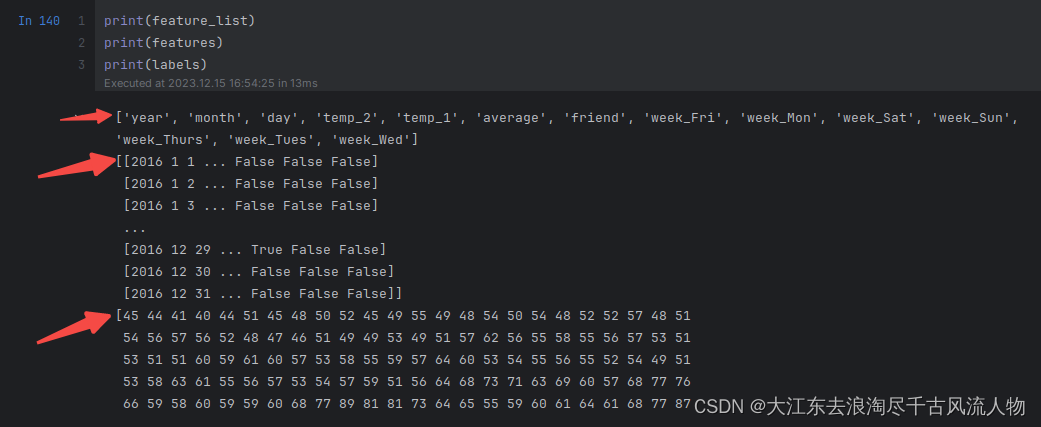
from sklearn import preprocessing
input_features = preprocessing.StandardScaler().fit_transform(features)
这行代码使用StandardScaler对特征进行标准化处理,包括均值移除和方差缩放,使得特征的均值为0,方差为1。fit_transform
方法用于对数据集进行拟合转换操作,将处理后的结果存储在input_features中。

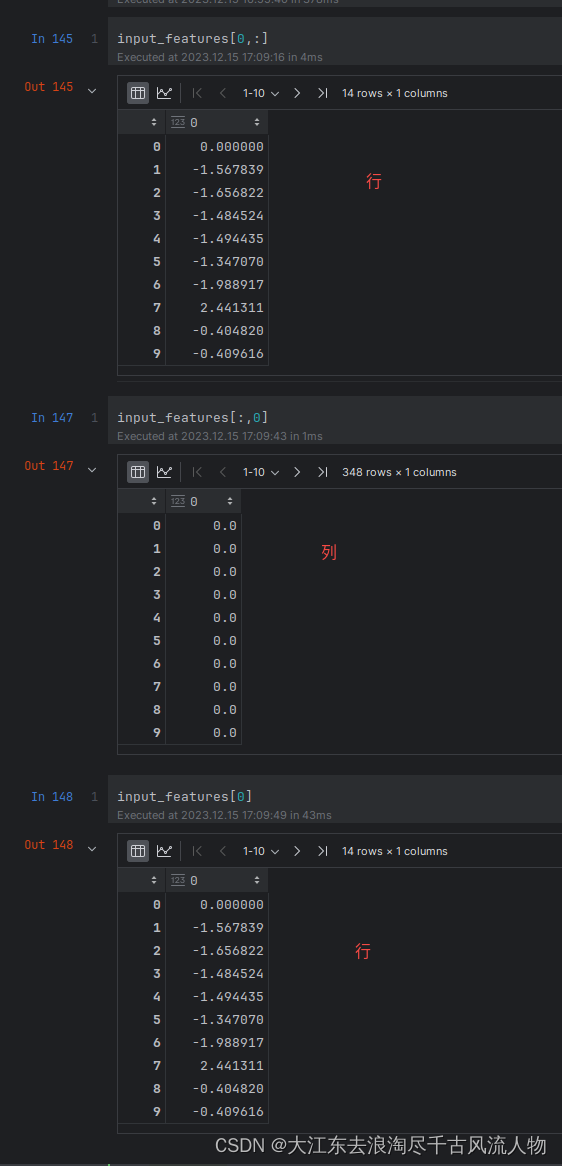
4 网络模型构建
4.1 方法1
x = torch.tensor(input_features, dtype = float)
y = torch.tensor(labels, dtype = float)
# 权重参数初始化
weights = torch.randn((14, 128), dtype = float, requires_grad = True)
biases = torch.randn(128, dtype = float, requires_grad = True)
weights2 = torch.randn((128, 1), dtype = float, requires_grad = True)
biases2 = torch.randn(1, dtype = float, requires_grad = True)
learning_rate = 0.001
losses = []
for i in range(1000):
# 计算隐层
hidden = x.mm(weights) + biases
# 加入激活函数
hidden = torch.relu(hidden)
# 预测结果
predictions = hidden.mm(weights2) + biases2
# 通计算损失
loss = torch.mean((predictions - y) ** 2)
losses.append(loss.data.numpy())
# 打印损失值
if i % 100 == 0:
print('loss:', loss)
#返向传播计算
loss.backward()
#更新参数
weights.data.add_(- learning_rate * weights.grad.data)
biases.data.add_(- learning_rate * biases.grad.data)
weights2.data.add_(- learning_rate * weights2.grad.data)
biases2.data.add_(- learning_rate * biases2.grad.data)
# 每次迭代都得记得清空
weights.grad.data.zero_()
biases.grad.data.zero_()
weights2.grad.data.zero_()
biases2.grad.data.zero_()
predictions.shape
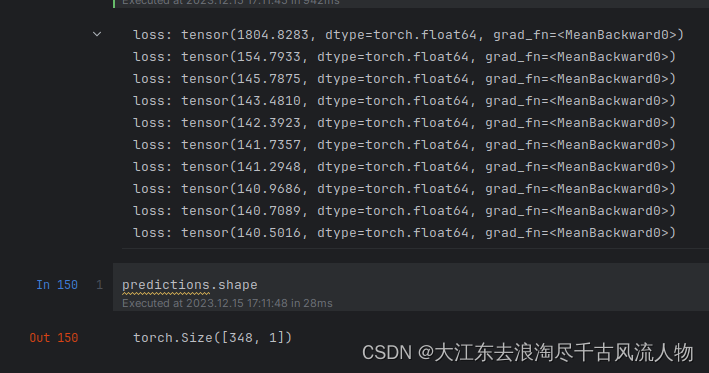
4.1 方法2(更简单的构建网络模型)
input_size = input_features.shape[1]
hidden_size = 128
output_size = 1
batch_size = 16
my_nn = torch.nn.Sequential(
torch.nn.Linear(input_size, hidden_size),
torch.nn.Sigmoid(),
torch.nn.Linear(hidden_size, output_size),
)
cost = torch.nn.MSELoss(reduction='mean')
optimizer = torch.optim.Adam(my_nn.parameters(), lr = 0.001)
# 训练网络
losses = []
for i in range(1000):
batch_loss = []
# MINI-Batch方法来进行训练
for start in range(0, len(input_features), batch_size):
end = start + batch_size if start + batch_size < len(input_features) else len(input_features)
xx = torch.tensor(input_features[start:end], dtype = torch.float, requires_grad = True)
yy = torch.tensor(labels[start:end], dtype = torch.float, requires_grad = True)
prediction = my_nn(xx)
loss = cost(prediction, yy)
optimizer.zero_grad()
loss.backward(retain_graph=True)
optimizer.step()
batch_loss.append(loss.data.numpy())
# 打印损失
if i % 100==0:
losses.append(np.mean(batch_loss))
print(i, np.mean(batch_loss))
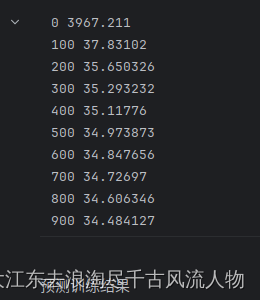
5. 网络模型预测使用测试
x = torch.tensor(input_features, dtype = torch.float)
predict = my_nn(x).data.numpy()
# 转换日期格式
dates = [str(int(year)) + '-' + str(int(month)) + '-' + str(int(day)) for year, month, day in zip(years, months, days)]
dates = [datetime.datetime.strptime(date, '%Y-%m-%d') for date in dates]
# 创建一个表格来存日期和其对应的标签数值
true_data = pd.DataFrame(data = {'date': dates, 'actual': labels})
# 同理,再创建一个来存日期和其对应的模型预测值
months = features[:, feature_list.index('month')]
days = features[:, feature_list.index('day')]
years = features[:, feature_list.index('year')]
test_dates = [str(int(year)) + '-' + str(int(month)) + '-' + str(int(day)) for year, month, day in zip(years, months, days)]
test_dates = [datetime.datetime.strptime(date, '%Y-%m-%d') for date in test_dates]
predictions_data = pd.DataFrame(data = {'date': test_dates, 'prediction': predict.reshape(-1)})
# 真实值
plt.plot(true_data['date'], true_data['actual'], 'b-', label = 'actual')
# 预测值
plt.plot(predictions_data['date'], predictions_data['prediction'], 'ro', label = 'prediction')
plt.xticks(rotation = '60');
plt.legend()
# 图名
plt.xlabel('Date'); plt.ylabel('Maximum Temperature (F)'); plt.title('Actual and Predicted Values');
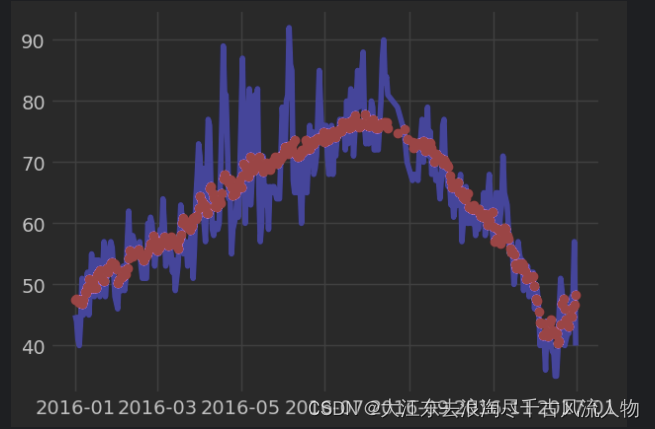
文章来源:https://blog.csdn.net/Darlingqiang/article/details/135016413
本文来自互联网用户投稿,该文观点仅代表作者本人,不代表本站立场。本站仅提供信息存储空间服务,不拥有所有权,不承担相关法律责任。 如若内容造成侵权/违法违规/事实不符,请联系我的编程经验分享网邮箱:veading@qq.com进行投诉反馈,一经查实,立即删除!
本文来自互联网用户投稿,该文观点仅代表作者本人,不代表本站立场。本站仅提供信息存储空间服务,不拥有所有权,不承担相关法律责任。 如若内容造成侵权/违法违规/事实不符,请联系我的编程经验分享网邮箱:veading@qq.com进行投诉反馈,一经查实,立即删除!